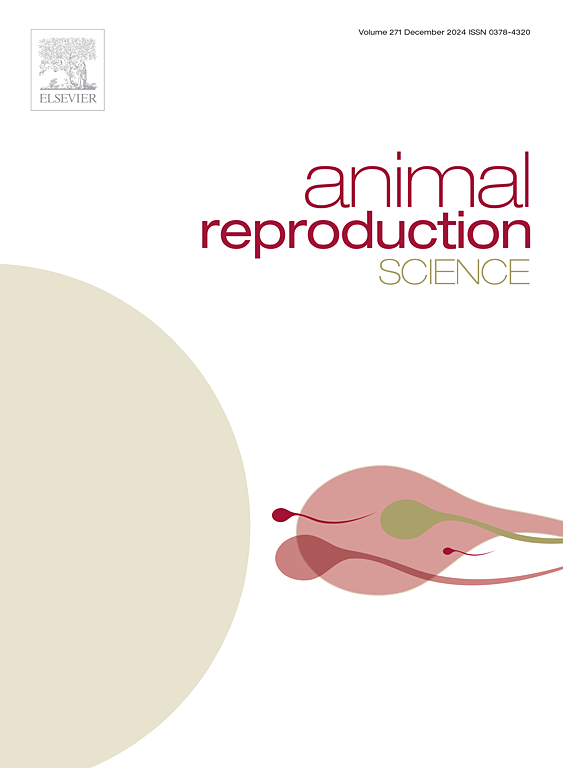种鱼龄和日粮对育成灰鲑配子质量和早期发育的影响
IF 3.3
2区 农林科学
Q1 AGRICULTURE, DAIRY & ANIMAL SCIENCE
引用次数: 0
摘要
在过去的几十年里,欧洲水域的灰鱼(胸腺)数量显著下降。关键的保护策略之一是在河流中放养孵化场饲养的鱼。为了改进孵化场对灰鲑的饲养工艺,本研究通过对灰鲑的卵生化组成、受精卵比例、精子浓度和流动性以及早期胚胎发育进行测量,研究了3+龄和4+龄和不同商业饲料对配子质量的影响。母鱼年龄成为影响繁殖成功的主要因素,年龄较大的母鱼表现出更高的繁殖力和更大的卵。此外,首次产卵的卵表现出较高的DHA/EPA比率,这可能与早期死亡综合征有关;然而,胚胎存活率在不同年龄组之间没有差异。年龄也会影响精子质量,老年男性的精子活力和速度较高,但浓度较低。饲料对配子质量有中等影响,影响卵子的生化组成,包括脂肪酸谱和精子浓度。结合繁殖性能,试验饲料均不能完全满足该物种最佳繁殖所需的营养需求。平均受精卵比例为70 %,至眼卵期成活率为25 %,幼虫孵化率低于10 %。观察到生长差异,雄性对富含碳水化合物的饮食反应积极。饲喂高碳水化合物饲料的雌性卵显示出n-3/n-6 PUFA比率的改变和必需脂肪酸水平的降低。研究结果强调了为灰鲑量身定制饵料的必要性,这既支持了灰鲑的生长,又支持了灰鲑的繁殖。本文章由计算机程序翻译,如有差异,请以英文原文为准。
Broodstock age and diet as determinants of gamete quality and early development in hatchery-reared grayling (Thymallus thymallus)
Grayling (Thymallus thymallus) populations have declined significantly in European waters over past few decades. One of key conservation strategies involves stocking rivers with hatchery-reared fish. To improve the grayling rearing processes in hatcheries, this two-year study investigates the effects of broodstock age (3+ and 4+) and different commercial feeds on gamete quality, measured through egg biochemical composition, fertile egg proportion, sperm concentration and mobility, and early embryonic development in grayling. Broodstock age emerged as the dominant factor influencing reproductive success, with older females demonstrating higher fecundity and larger eggs. In addition, eggs of first-time spawners exhibited higher DHA/EPA ratios, which may be linked to early mortality syndromes; however, no differences in embryo survival were observed between age groups. Age also affected sperm quality, with higher progressive motility and velocity, but lower concentration in older males. Feed had a moderate effect on gamete quality, influencing the biochemical composition of eggs, including fatty acid profiles, and sperm concentration. Combined with reproductive performance, it was concluded that none of the tested feeds fully met the species' nutritional requirements for optimal reproduction. The average fertile egg proportion was 70 %, survival to the eyed egg stage was 25 %, and the hatching rate of larvae was below 10 %. Growth differences were observed, with males responding positively to carbohydrate-rich diets. Eggs from females fed high-carbohydrate diets exhibited altered n-3/n-6 PUFA ratios and reduced essential fatty acid levels. The findings underscore the necessity for tailored broodstock feed for grayling, which supports both growth and reproduction.
求助全文
通过发布文献求助,成功后即可免费获取论文全文。
去求助
来源期刊

Animal Reproduction Science
农林科学-奶制品与动物科学
CiteScore
4.50
自引率
9.10%
发文量
136
审稿时长
54 days
期刊介绍:
Animal Reproduction Science publishes results from studies relating to reproduction and fertility in animals. This includes both fundamental research and applied studies, including management practices that increase our understanding of the biology and manipulation of reproduction. Manuscripts should go into depth in the mechanisms involved in the research reported, rather than a give a mere description of findings. The focus is on animals that are useful to humans including food- and fibre-producing; companion/recreational; captive; and endangered species including zoo animals, but excluding laboratory animals unless the results of the study provide new information that impacts the basic understanding of the biology or manipulation of reproduction.
The journal''s scope includes the study of reproductive physiology and endocrinology, reproductive cycles, natural and artificial control of reproduction, preservation and use of gametes and embryos, pregnancy and parturition, infertility and sterility, diagnostic and therapeutic techniques.
The Editorial Board of Animal Reproduction Science has decided not to publish papers in which there is an exclusive examination of the in vitro development of oocytes and embryos; however, there will be consideration of papers that include in vitro studies where the source of the oocytes and/or development of the embryos beyond the blastocyst stage is part of the experimental design.
 求助内容:
求助内容: 应助结果提醒方式:
应助结果提醒方式:


